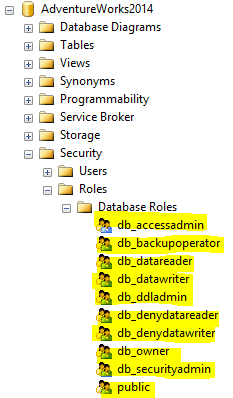Three Reasons to Use a Custom Database Role
Ever had a situation where a small in-house application written for a small group of employees needed some permissions in the database? How do you handle that? I want to walk through the scenario and provide three reasons that using a Database Role might be the answer you are looking for.
Let’s first cover, at a high level, the different levels of permissions in SQL Server and the associated commands. In SQL Server there are Server level permissions for the SQL instance and there are database level permissions. Within the database level there are also specific permissions for objects like tables, views and store procedures. There are also database permissions that can be grouped together in a database role. In fact, there are some built-in database roles for SQL Server as shown below. If you aren’t familiar with these, you can find out about them here.
As an example, suppose there is an application being written for a small department in your company. The application needs access to your company database, but not access to everything in the database. Perhaps the app only touches a few tables. Someone could grant the Server level permission of SysAdmin to a Windows account or Windows group that contains the necessary people added to it in Active Directory. That would be a “sledge hammer” approach to providing permissions and break the principle of least privilege. In this scenario, a database role could be used to accomplish the task at hand.
On your domain you or the System Administrator can create a group called MyDomain\DepartmentName. With the pseudo-code below as a model, you can create the Login and User.
USE master; GO CREATE LOGIN [MyDomain\DepartmentName] FOR WINDOWS USE MyDatabase; GO CREATE USER [MyDomain\ DepartmentName] FOR LOGIN [MyDomain\ DepartmentName]
In this new AD group, you place the members of the department. This allows the department members the ability to use their already familiar Windows passwords, keeping it easier for them. Using Windows groups also makes it easier for you. If you aren’t convinced of that read this post.
At this point is when some people might still take the approach of giving big permissions by mapping the created database user to the db_owner role in the database and be done with the process of permissions. However, do you really want a group of people in a department to have complete control over the entire database. Somehow I doubt it, and I doubt your auditors want to see that either.
Permissions could be granted to the user account itself inside SQL Server, but what if other people who are not yet in the appropriate AD group want access? Now you either have to add them to that AD group, which might now make sense from an organizational perspective, or you have to start this process all over again with a new login and user. This is where Database Roles come in. Below is example code on how you would do that based on the process we already have in place.
USE MyDB; GO CREATE ROLE MyNewDBRole; GO ALTER ROLE ADD MEMBER [MyDomain\ DepartmentName]; GO GRANT EXECUTE ON [dbo].[GetEmployees] TO MyNewDBRole; GO GRANT EXECUTE ON [dbo].[InsertEmployee] TO MyNewDBRole; GO GRANT EXECUTE ON [dbo].[DeleteEmployee] TO MyNewDBRole; GO GRANT EXECUTE ON [dbo].UpdateEmployee] TO MyNewDBRole; GO GRANT EXECUTE ON [dbo].[GetSales] TO MyNewDBRole;
So what are some reasons to use a process like this? First, the application will follow the principle of least privileges. This means that the application and the users of the application will only have the permissions required for the functionality of the application. This keeps your SQL Server more secure, which makes auditors happy.
Second, this type of process eases administration. When the application is expanded and more people begin to use it and for different purposes, just create a group like the first one demonstrated and add the group to the role. Grant any additional permissions needed to the role. No adding individual logins to the SQL Server and no applying permissions to many individual logins, which would be a pain. Now you have a single point of permissions administration within SQL Server – the Database Role. Additionally, if there are new employees in the department who need access to the application, simply add those people to the AD group and you’re done!
Third, you and the System Administrator get some face time!! Who doesn’t like a little collaboration?




